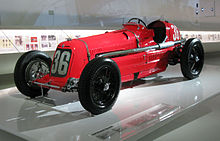
Tazio Giorgio Nuvolari was an Italian racing driver. He first raced motorcycles and then concentrated on sports cars and single-seaters. Originary of Mantua, he was nicknamed Il Mantovano Volante and Nivola ("Cloud"). His victories—72 major races, 150 in all—included 24 Grands Prix, five Coppa Cianos, two Mille Miglias, two Targa Florios, two RAC Tourist Trophies, a Le Mans 24-hour race, and a European Championship in Grand Prix racing. Ferdinand Porsche called him "the greatest driver of the past, the present, and the future".
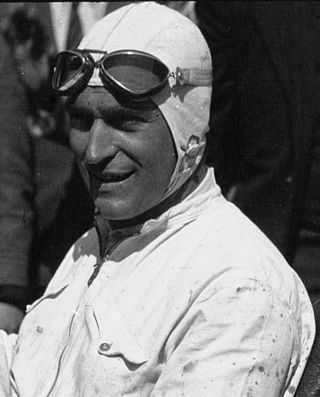
Luigi Cristiano Fagioli, nicknamed "the Abruzzi robber", was an Italian motor racing driver. Having won his last race at 53 years old, Fagioli holds the record for the oldest Formula One driver to win a race. He is also the only Formula One Grand Prix winner born in the 19th century, and the only Grand Prix racing driver to have won a championship race in both the AIACR European Championship and the FIA Formula One World Championship.

Philippe Jean-Armand Étancelin was a French Grand Prix motor racing driver who joined the new Formula One circuit at its inception.
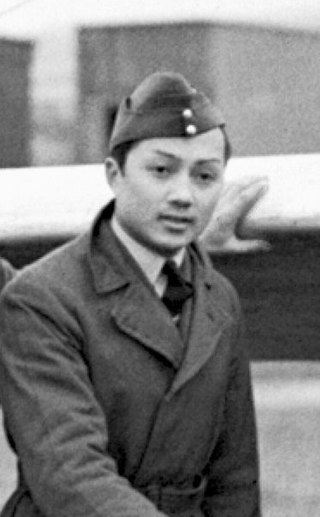
Prince Birabongse Bhanudej Bhanubandh, better known as Prince Bira of Siam or by his nom de courseB. Bira, was a member of the Thai royal family, racing driver, sailor, and pilot.
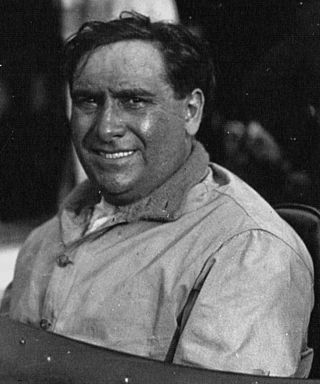
Giuseppe Campari was an Italian opera singer and Grand Prix motor racing driver.
Baconin Borzacchini was an Italian Grand Prix motor racing driver often referred to as Mario Umberto Borzacchini.

The 1936 Grand Prix season was the third year of the 750 kg Formula. The next iteration of the Mercedes-Benz did not prove successful and the team withdrew during the season to instead prepare for the next one. It therefore fell to the resurgent Auto Union team to dominate the racing. In particular, it was their young, new superstar, Bernd Rosemeyer, who mastered the tricky car and who showed superlative skill in wet conditions. Rosemeyer easily won this season's European Championship by winning three of the four Grands Prix.
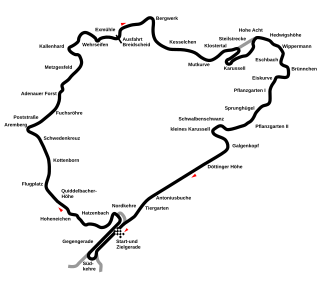
The 1935 German Grand Prix was a Grand Prix motor race held at the Nürburgring on 28 July 1935.

The Alfa Romeo P3, P3 monoposto or Tipo B was a classic Grand Prix car designed by Vittorio Jano, one of the Alfa Romeo 8C models. The P3 was first genuine single-seat Grand Prix racing car and Alfa Romeo's second monoposto after Tipo A monoposto (1931). It was based on the earlier successful Alfa Romeo P2. Taking lessons learned from that car, Jano went back to the drawing board to design a car that could last longer race distances.

The Maserati 8C was a Grand Prix race car built by Maserati between 1931 and 1933. The 8C was being designed by Alfieri Maserati in the early 1930s; however, he died before its completion. The chassis was that of the Maserati Tipo 26M, and it was initially fitted with a Tipo 26M engine with its cylinders bored out by 4 mm to arrive at its limit of 2.8 litres. Development of the new 3.0 L engine continued and it was constructed for racing in 1932. The car won the 1933 French Grand Prix and Sir Henry Birkin achieved third place driving it in the Tripoli Grand Prix. However, it was not very successful in other races. The car featured some of the world's earliest hydraulic brakes. The Tipo 8C 3000 was the final two-seater Grand Prix Maserati, and was succeeded in 1933 by the Maserati 8CM, M for monoposto.

The 1935 Grand Prix season was the second year of the new 750 kg Formula. The success of the previous year encouraged the AIACR to reinitiate the European Championship. It was composed of the seven national Grands Prix and was won by Rudolf Caracciola, driving for the Mercedes-Benz team. The team dominated the season winning five of those Grand Épreuves, as well as four of the other major races of the season. However, in one of the great motor-races in sporting history, Tazio Nuvolari in a Scuderia Ferrari Alfa Romeo beat the combined numbers of the German teams in their home Grand Prix. The season also saw the arrival on the international stage of the bright young talent Bernd Rosemeyer in the Auto Union team.
Brian Edmund Lewis, 2nd Baron Essendon, also known as Bug, was a British motor-racing driver, company director, baronet, and peer.

The 1933 Grand Prix season was an intermediate year, as it would be the last season for the current AIACR regulations before a new weight-formula was introduced in 1934. As such, the European Championship was not held and the manufacturers held back on further developments of their existing models. Alfa Romeo, following an Italian government financial bailout and like Mercedes-Benz the previous year, had shut down its Alfa Corse works team. Scuderia Ferrari, their regular customer team took up the role of racing Alfa Romeos and a number of ex-works drivers moved across to join their ranks. They were not allowed, however, to buy the impressive Tipo B that had been so dominant in the previous season.
The 1934 Grand Prix season saw the advent of the new 750 kg Formula. In an effort to curb the danger of rising speeds, the AIACR imposed this upper weight limit that effectively outlawed the large capacity engines. The incumbent manufacturers Alfa Romeo, Maserati and Bugatti had been preparing their new models with varying success – the best of which was the Alfa Romeo Tipo B. However, it was the state-sponsored arrival of the two German teams, Mercedes-Benz and Auto Union, and their innovative and progressive cars that ignited a new, exciting era of motor racing.

Giovanni “Johnny” Lurani Cernuschi, VIII Count of Calvenzano was an Italian automobile engineer, racing car driver and journalist.
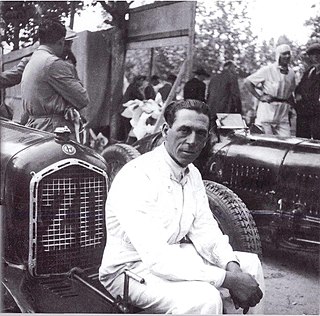
Pietro Ghersi was an Italian motorcycle racer and, from 1927, also a racecar driver. He was born in Genoa.

László Hartmann was a Hungarian Grand Prix motor racing driver.

The 1933 French Grand Prix was a Grand Prix motor race which was run on 11 June 1933, in Montlhéry, France. Organized by the French Automobile Club, it was XXVII running of the Grand Prix de l'Automobile Club de France. The race, which was held over 40 laps, was won by the Italian driver Giuseppe Campari in a privately entered Maserati. It was to be Campari's final victory, as he was killed just three months later at Monza. Philippe Étancelin and George Eyston, both in privateer Alfa Romeos, finished in second and third, respectively.
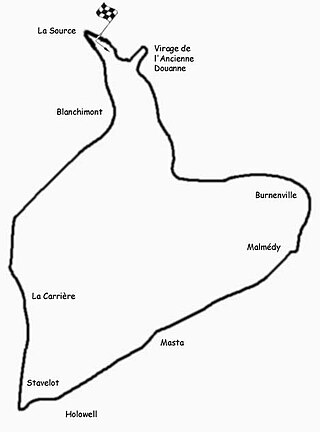
The 1933 Belgian Grand Prix was a Grand Prix motor race held at Spa-Francorchamps on 9 July 1933. The 40-lap race was won by Tazio Nuvolari, of Scuderia Ferrari, driving a Maserati. Second and third were taken by the works Bugatti drivers Achille Varzi and René Dreyfus.

The Maserati 6C 34 is a 750 kg open-wheel Grand Prix race car, designed, developed and built by Maserati from 1934 to 1935.

